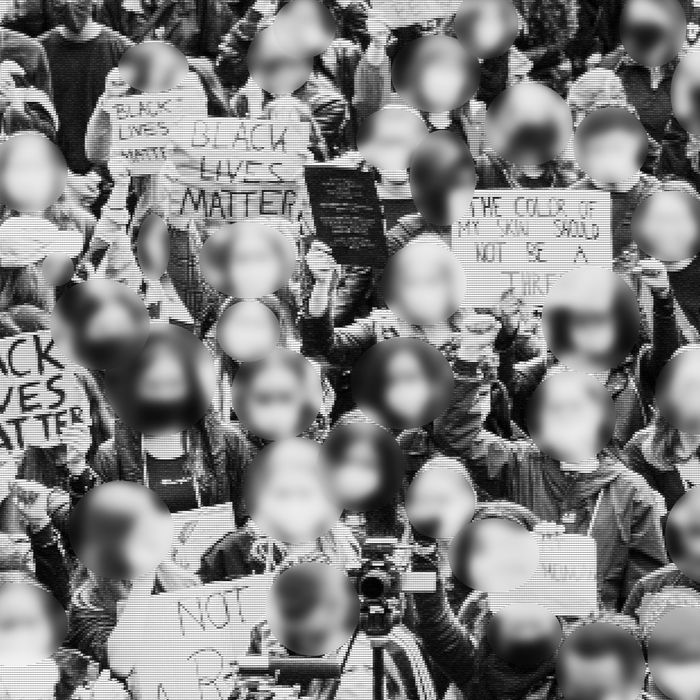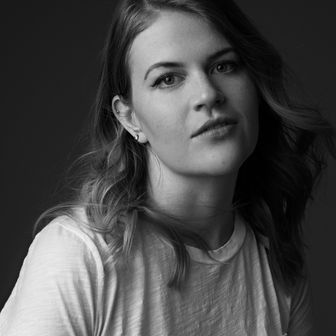
On the evening of Friday, May 29, a Twitter user began livestreaming the growing crowd outside Brooklyn’s Barclays Center to protest the killing of George Floyd. The stream was shaky and grainy, jerking from the police in riot gear to the chanting demonstrators facing them. At the bottom of the screen, comments from viewers flooded in, most of them carrying the same message for the person streaming: Don’t show protesters’ faces.
The next day, a similar dynamic played out on the Cut’s Instagram account: We shared photos from that same protest, and many of our followers expressed that same concern. We removed the images where faces were clearly visible, but we were left with questions about it. We knew it was an issue we would have to address again.
As demonstrations against police brutality and white supremacy have swept across the country, protesters and journalists alike have carefully documented the demonstrations, sharing thousands of photos and videos to social media. These images capture an experience, a moment in history. For many, they also serve as a way to record police officers’ potential transgressions. (At several protests in Brooklyn, as demonstrators approached a line of cops, someone would shout, “Phones out!”) At the same time, there has been a growing push among Black Lives Matter supporters, both on- and offline, for both photojournalists and private citizens to refrain from sharing photos of participants’ faces. Doing so, many fear, would make it easier for police to identify the protesters — and then, potentially, surveil them, harass them, or arrest them.
Many journalists, meanwhile, argue that to somehow blur or avoid the faces of those protesting would not be telling the full story.
“You have to humanize the protest and the struggle,” Eric Baradat, the AFP photo editor for North America told the Cut over the phone one afternoon. Baradat said he has confronted this question while covering uprisings in Europe, Asia, and the Middle East, and that ultimately, he believes it is a journalist’s job to cover the reality of what is happening in front of them. And to convey the emotional reality of a situation, faces are essential.
“If you don’t have the faces of the protesters in 1968 in Prague, you don’t have a story. If you don’t have the people trying to take down the wall in Berlin in 1989, you don’t have a story. If you don’t have the faces of the protesters in Tiananmen Square, you don’t show to the rest of the world the reality of the situation,” Baradat argues.
Perhaps the best recent example, for both sides of the debate, is one of the St. Louis Post-Dispatch’s Pulitzer Prize–winning photos from the 2014 protests in Ferguson, Missouri, following the killing of an unarmed Black teen, Michael Brown, by a police officer. In the picture, St. Louis resident Edward Crawford can be seen throwing a tear gas canister that police had shot into a crowd of protesters. Crawford is wearing an American flag shirt, his long locs swept across his face, a bag of chips in one hand, and the flaming canister in the other. Behind Crawford, two other protesters cheer. It’s a powerful image, one that came to symbolize the desperation and anger so many communities felt about police killings of unarmed Black people.
A year after the photo was taken, however, the St. Louis County counselor pressed charges against Crawford relating to the tear gas scene, claiming that he had assaulted an officer by “throwing a burning gas canister.” Crawford, meanwhile, said that he hadn’t thrown it at police — he’d thrown it away from the crowd. “I threw it out of the way of children,” he told the Post-Dispatch.
Crawford died in 2017. His death was ruled a suicide by police, but many people, including Crawford’s family, were suspicious. Crawford was one of six men tied to the Ferguson protests who died in the years after the demonstrations. Other activists reported experiencing harassment following their work at the protests. “Something is happening,” Cori Bush, a frequent leader of the Ferguson protests, told NBC News in 2019. “I’ve been vocal about the things that I’ve experienced and still experience — the harassment, the intimidation, the death threats, the death attempts.”
Crawford’s death, and those of the other Ferguson protesters, are often cited as examples of why individuals and media companies should avoid posting photos in which protesters are easily identifiable.
“Six young men died within the first 4 years following Ferguson. All with ties to the movement. Mysteriously,” tweeted writer Resita Cox in June. “When we say blur ppl faces we mean, you bout to get folks killed for Instagram views and retweets.”
In Crawford’s case, at least, it’s not clear whether the iconic image and his death are linked. Pulitzer Prize–winning journalist Wesley Lowery — who rose to prominence following his on-the-ground coverage of the Ferguson protests, and who knew Crawford personally — is skeptical of a connection, writing on Twitter:“I’m glad history knows who Edward Crawford — one of the first people I ever interviewed in Ferguson and who I got to know well — was, and that he is remembered by name. There is no responsible reading of the facts to support the suggestion his death was the result of targeting.”
So what exactly is the threat posed by posting images of protesters’ faces? And does the answer differ whether you’re a journalist publishing to a national media outlet — or a private citizen posting to your Instagram?
“There is a legitimate ethical discussion to be had about how the media can reduce harm,” Lowery followed up. “But arguing that because ‘the Ferguson protesters were targeted/killed’ due to their photos has no basis in reality. And I say that as someone who knew personally and cared about those people.”
Even so, publishing a photo in which a Black Lives Matter protester’s face is visible and identifiable could potentially put protesters at risk for future criminal charges if the photograph is used as evidence; consider how Crawford was charged for assault following the tear gas incident. While the photograph may not have been the only factor at play, then–St. Louis County counselor Peter Krane, who pressed the charges against Crawford, said at the time that before pressing charges, his office had reviewed media reports and social-media posts of the incident.
When deciding whether to post an image, though, can the newsworthiness of a photograph ever outweigh the potential risk posed to those in the photograph? According to the Society of Professional Journalists’ code of ethics, one of the most important principles of journalism is to “seek truth and report it.” But an equally important principle is to “minimize harm.” To that end, on May 31, the Authority Collective — a group of “womxn, non-binary and gender expansive people of color working in the photography, film and VR/AR industries” — proposed a set of guidelines for reporters photographing police-brutality protests which included this directive: “You cannot put the lives of people you document in danger under the guise of objective journalism.”
These seem like questions for editors to argue over in newsrooms. But what if you’re not a journalist at all, but a private citizen, taking pictures to post for your friends and family on social media? The FBI, for one, is interested in your footage: On June 1, the government agency issued a request seeking “digital media depicting violent encounters surrounding the civil unrest” — photos or videos, in other words, of people who could be potentially charged with looting or vandalism. And on May 30, the Dallas Police Department tweeted that people should download its iWatch Dallas app to upload footage of protesters committing crimes. (K-Pop fans quickly flooded the app with fancam videos, rendering it useless.)
But even if you’re not going out of your way to share footage from protests with law enforcement, police departments regularly scour social media to monitor and identify individuals they think might be connected to a crime.
“I think it’s correct that protesters should be really careful of posting videos or photographs that allow police to identify individuals who may not want to be identified,” said Faiza Patel, the co-director of the Brennan Center’s Liberty & National Security Program. Even so, while demonstrators posting pictures of each other online is a real concern, it is tempered by the fact that police are undoubtedly in the protests taking photos and videos themselves, she explained. Surveillance of protests is happening whether protesters post a single image of each other or not.
This type of monitoring of civilians has precedent too. In the 1960s, police around the country monitored activist groups like the Black Panthers with wiretaps, long-lenses, and undercover operations. With the advent of the internet, facial recognition technology and social media, police surveillance became even more sophisticated: Prior to the 2004 Republican National Convention, police collected detailed data on those who planned to demonstrate; in 2011, following the Occupy Wall Street protests, demonstrators reported being subjected to heavy police monitoring, including having police come and search their homes.
In recent years, the NYPD has been collecting files on members of the Black Lives Matter movement, and holding on to photos of individual demonstrators for years. A trove of emails obtained by the website The Appeal in 2019 showed that from late 2014 to early 2015, NYPD officers sent around pictures of protesters taken by undercover cops, and social media posts from Twitter.
More pressing than whether or not to post a protest pic to your Instagram, Patel argues, is this: Once police departments get these images, few safeguards exist concerning how they use the information. How long can they keep them? What other purposes can they be used for? Who can access them? “We have these large protests going on and we don’t really know what technology the police are using, and what safeguards there are around it.”
There are no clear-cut answers here, for journalists or individuals. Each publication must determine what they feel is ethical. Pictures can help inspire, strengthen, and grow a movement. They can galvanize people into action. Some people want to be photographed, to be seen so that their stories will be heard. At the same time, identifiable pictures of protesters, on social media and in publications, can potentially be used as evidence against them should they be arrested. Perhaps, when possible, ask the people in your photos if they would mind being identified, and if that’s not an option, ask yourself if posting might cause undue harm. But whatever you do, ask yourself who you’re really doing it for first.


